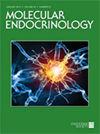fos -拉链GH受体细胞质尾部作为Jak2底物和信号转导。
Q Biochemistry, Genetics and Molecular Biology
引用次数: 3
摘要
Janus激酶(Jak)家族成员启动细胞因子受体家族的大多数下游信号事件。普遍的原理是受体以二聚体的形式发挥作用:2个Jak2分子结合到细胞因子受体家族成员的细胞质尾部,在同源细胞因子诱导的受体复合体构象变化中启动Jak2信号转换器和转录信号激活器。由于信号复合物的复杂性,迫切需要体外模型系统。为了研究Jak2与GH受体(GHR)相互作用的分子细节,我们使用了含有c-Fos衍生的亮氨酸拉链的细胞质尾部来模拟GHR的二聚体状态。与Jak2一起表达时,fos- zippped tails是稳定的,而非unzippped tails。此外,jak信号转导因子和转录信号通路的激活因子被fos- zippers尾部激活。稳定性还取决于拉链的α-螺旋旋转。从杆状病毒感染的昆虫细胞中纯化的fos拉链GHR尾部和Jak2通过box1相互作用,其结合亲和力约为40nM。正如预期的那样,Jak激酶抑制剂Ruxolitinib抑制了稳定性,但不影响c- fos拉链GHR尾部与jak2的相互作用。蓝色凝胶电泳分析显示,高分子量复合物含有Jak2和非磷酸化的GHR尾部,而Jak2解离的尾部是高度磷酸化的单体,这意味着Jak2在磷酸化后与底物分离。本文章由计算机程序翻译,如有差异,请以英文原文为准。
Fos-Zippered GH Receptor Cytosolic Tails Act as Jak2 Substrates and Signal Transducers.
Members of the Janus kinase (Jak) family initiate the majority of downstream signaling events of the cytokine receptor family. The prevailing principle is that the receptors act in dimers: 2 Jak2 molecules bind to the cytosolic tails of a cytokine receptor family member and initiate Jak-signal transducer and activator of transcription signaling upon a conformational change in the receptor complex, induced by the cognate cytokine. Due to the complexity of signaling complexes, there is a strong need for in vitro model systems. To investigate the molecular details of the Jak2 interaction with the GH receptor (GHR), we used cytosolic tails provided with leucine zippers derived from c-Fos to mimic the dimerized state of GHR. Expressed together with Jak2, fos-zippered tails, but not unzippered tails, were stabilized. In addition, the Jak-signal transducer and activator of transcription signaling pathway was activated by the fos-zippered tails. The stabilization depended also on α-helix rotation of the zippers. Fos-zippered GHR tails and Jak2, both purified from baculovirus-infected insect cells, interacted via box1 with a binding affinity of approximately 40nM. As expected, the Jak kinase inhibitor Ruxolitinib inhibited the stabilization but did not affect the c-Fos-zippered GHR tail-Jak2 interaction. Analysis by blue-native gel electrophoresis revealed high molecular-weight complexes containing both Jak2 and nonphosphorylated GHR tails, whereas Jak2-dissociated tails were highly phosphorylated and monomeric, implying that Jak2 detaches from its substrate upon phosphorylation.
求助全文
通过发布文献求助,成功后即可免费获取论文全文。
去求助
来源期刊

Molecular endocrinology
医学-内分泌学与代谢
CiteScore
3.49
自引率
0.00%
发文量
0
审稿时长
12 months
期刊介绍:
Molecular Endocrinology provides a forum for papers devoted to describing molecular mechanisms by which hormones and related compounds regulate function. It has quickly achieved a reputation as a high visibility journal with very rapid communication of cutting edge science: the average turnaround time is 28 days from manuscript receipt to first decision, and accepted manuscripts are published online within a week through Rapid Electronic Publication. In the 2008 Journal Citation Report, Molecular Endocrinology is ranked 16th out of 93 journals in the Endocrinology and Metabolism category, with an Impact Factor of 5.389.
 求助内容:
求助内容: 应助结果提醒方式:
应助结果提醒方式:


